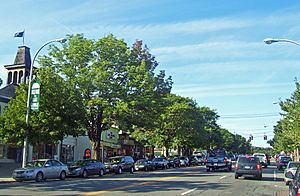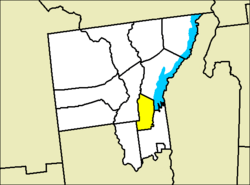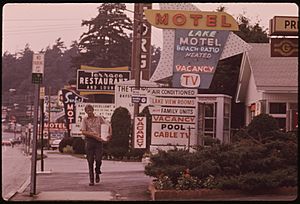Lake George (town), New York facts for kids
Quick facts for kids
Lake George
|
|
|---|---|

Downtown Lake George
|
|

Location of Lake George in Warren County
|
|
| Country | United States |
| State | New York |
| County | Warren |
| Area | |
| • Total | 32.62 sq mi (84.48 km2) |
| • Land | 30.07 sq mi (77.88 km2) |
| • Water | 2.55 sq mi (6.60 km2) |
| Population
(2020)
|
|
| • Total | 3,502 |
| • Density | 107.36/sq mi (41.454/km2) |
| Time zone | UTC-5 (Eastern (EST)) |
| • Summer (DST) | UTC-4 (EDT) |
| ZIP code |
12845
|
| Area code(s) | 518 |
Lake George is a town located in Warren County, New York, in the United States. It is named after the famous Lake George itself. In 2020, about 3,502 people lived in the town. Lake George is a popular place for tourists and is part of the larger Glens Falls area.
Contents
History of Lake George
Early Explorers and Naming
The first European to see Lake George was a French missionary named Father Isaac Jogues. He visited the lake in August 1642. Later, in 1646, he returned and named the lake "Lac du Saint Sacrement," which means "Lake of the Blessed Sacrament."
Many years later, in 1755, a British general named William Johnson renamed the lake. He chose the name "Lake George" to honor King George II of Great Britain.
Fort William Henry and Famous Stories
Lake George was an important place during the French and Indian War. A fort called Fort William Henry was built there. General Johnson named this fort after Prince William Henry, who was King George II's grandson.
In 1757, the French army and their Native American allies attacked Fort William Henry. After a six-day battle, the fort surrendered. This event and the conflict that followed became famous in the novel The Last of the Mohicans by James Fenimore Cooper. Today, the fort has been rebuilt and is open to visitors as a museum.
Town's Beginning and Growth
The town of Lake George was officially created in 1810. It was first called the "Town of Caldwell." Parts of nearby towns like Bolton, Queensbury, and Thurman were used to form it. In 1962, the town changed its name to Lake George, matching the lake it sits beside.
The town is also home to Wiawaka, a special retreat center. It started in 1903 to help women who worked in textile factories. Now, it's a nonprofit organization open to everyone.
Historic Sites in Lake George
Several important places in Lake George are listed on the National Register of Historic Places. These include:
- The FORWARD shipwreck site (a motor launch).
- The Royal C. Peabody Estate.
- The Wiawaka Bateaux Site.
- The Wiawaka Holiday House.
Two sites are even more important and are called National Historic Landmarks:
The Lake George Battlefield Park Historic District was added to the list of historic places in 2011.
Geography of Lake George
Lake George town covers about 32.7 square miles (84.7 square kilometers). Most of this area is land, about 30.2 square miles (78.2 square kilometers). The rest, about 2.5 square miles (6.5 square kilometers), is water.
The lake itself, Lake George, is quite long. It stretches for about 32 miles (51 kilometers). At its widest point, it is about two miles (3.2 kilometers) across. The Adirondack Northway, a major highway, also runs through the town.
Population and People
| Historical population | |||
|---|---|---|---|
| Census | Pop. | %± | |
| 1820 | 723 | — | |
| 1830 | 797 | 10.2% | |
| 1840 | 693 | −13.0% | |
| 1850 | 752 | 8.5% | |
| 1860 | 1,074 | 42.8% | |
| 1870 | 1,041 | −3.1% | |
| 1880 | 1,223 | 17.5% | |
| 1890 | 1,377 | 12.6% | |
| 1900 | 1,465 | 6.4% | |
| 1910 | 1,482 | 1.2% | |
| 1920 | 1,297 | −12.5% | |
| 1930 | 1,730 | 33.4% | |
| 1940 | 1,467 | −15.2% | |
| 1950 | 1,621 | 10.5% | |
| 1960 | 2,429 | 49.8% | |
| 1970 | 2,806 | 15.5% | |
| 1980 | 3,394 | 21.0% | |
| 1990 | 3,211 | −5.4% | |
| 2000 | 3,578 | 11.4% | |
| 2010 | 3,515 | −1.8% | |
| 2020 | 3,502 | −0.4% | |
| U.S. Decennial Census | |||
As of the census in 2000, there were 3,578 people living in the town of Lake George. The population density was about 118 people per square mile (45.6 people per square kilometer).
The average age of people in the town was 42 years old. About 21.7% of the population was under 18 years old.
Communities and Locations in Lake George Town
- Big Hollow – A small community located northwest of Lake George village.
- Bloody Pond – A pond in the southern part of town. It got its name from a battle that happened nearby during the French and Indian War.
- Crosbyside – Another small community, found east of Lake George village.
- Diamond Point – A community located north of Lake George village, right on the western shore of Lake George.
- Fort William Henry – The rebuilt historic fort is located in Lake George village. It was originally built by the British during the French and Indian War.
- Lake George – This is the main village located at the very southern end of Lake George.
- Prospect Mountain – A mountain close to the Big Hollow community.
See also
 In Spanish: Lake George (Nueva York) para niños
In Spanish: Lake George (Nueva York) para niños



